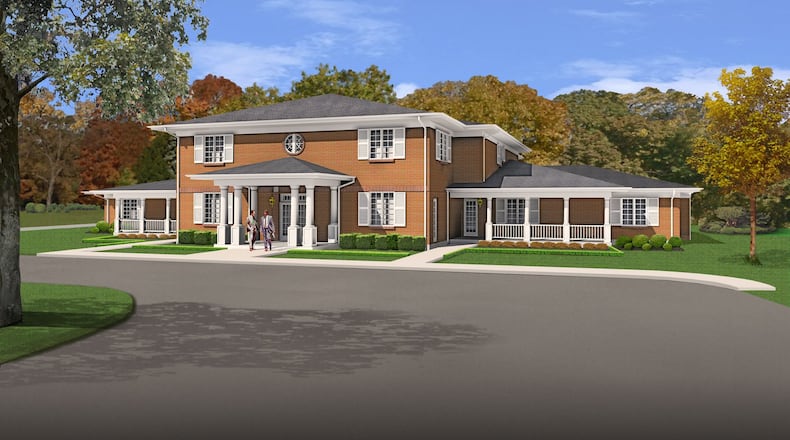Initially, project leaders targeted this year to open the 16-suite house to coincide with the 150th anniversary of the Dayton VA.
The new lodging house is expected to open in 2018 after 12 to 15 months of construction.
The Fisher House Foundation will contribute $5.5 million, and area real estate developer Randy Gunlock and his wife, Vicki, donated $1.075 million through the Greener Pastures Foundation.
Project fundraisers have raised $645,000 to help cover costs, surpassing a goal to raise at least $500,000, according to Chris Stanley, area executive director of the non-profit Fisher/Nightingale Houses, Inc.
“It is and will be an ongoing need,” Stanley, a retired Air Force senior master sergeant, said in an email.
RELATED: Funding goal of $500K set to build Fisher House
The Fisher House Foundation will donate the new home to the Dayton VA, which will staff the facility, officials say.
Much of the sprawling Dayton VA campus has been designated a National Historic Landmark, and it has been designated the future home of a national VA history and heritage center. The demolition of the old homes had to be reviewed under a federal law covering U.S. government agencies.
“We are very mindful of the historic nature of the Dayton campus and we do take seriously the need to honor its heritage and be mindful of the special designation it holds,” Fisher House Foundation President David A. Coker said in an telephone interview Wesdnesday from Rockville, Md.
The Dayton VA spent $591,000 to hire the contractor JohnsonDanforth & Associates, which has an office in Blue Ash, Ohio, to demolish the two buildings last week and to hook up utility connections to the site, said Kimberly Frisco, a Dayton VA spokeswoman.
The VA spent an additional $116,763, part of which paid for a feasibility report Indianapolis-based Guidon Design conducted that concluded stabilizing and moving one of the two old homes, Building 220, was “cost prohibitive.” The expense would have reached about $1.5 million, according to Dayton VA spokesman Ted Froats.
The other building was judged too far in disrepair or “already beyond saving” to consider alternatives, according to Froats. The State Historic Preservation Office and National Park Service signed off on the removal, Froats said.
Crews demolished Building 220, a two-story brick home built in 1885 that was once a hospitality house but closed two years ago because of deteriorating conditions, and Building 221, a two-story Victorian wooden home built in 1871 that was in disrepair, officials have said. Both homes were former residences and had not been in use in recent years.
“The decision to remove the old buildings did not come lightly and was done in close partnership with the State Historic Preservation Office, National Park Service, and other history-related entities,” Froats said in an email.
The site where the Fisher House will rise was selected because it’s “ideally located” near the main hospital and hospice units on campus, Froats added.
The American Veterans Heritage Center, dedicated to preserving history on the campus that is part of a National Historic Landmark, explored potentially saving the old structures.
“We agreed at a meeting that the Fisher House is an absolutely needed facility on campus and that while our preference is to preserve every old building we would not want to stand in the way of the Fisher House project because of the desperate need for it,” said Walter H. Rice, AVHC president and a federal judge in Dayton.
RELATED: $6 million Fisher House aid local veterans, families
Rice said the preservation group posed two questions: Did the Fisher House have to be located where it was, and if so could the old homes be moved.
Originally, three potential sites were explored for the new Fisher House on the sprawling VA campus.
One site was on land needed for a future expansion of the St. Mary’s Development Corp.’s Lyons Place housing, and the other was deemed “too hilly” for handicapped accessibility to and from the hospital for veterans who travel the route, Rice said.
A suggestion of “shoehorning” the house between the two old homes was rejected by Fisher House Foundation representatives, he said. Coker said with the 14,800-square-feet size of the house and the need for wheelchair accessibility “there was really no way to shoehorn between the two buildings.”
The AVHC at the Dayton VA reached the conclusion it was too expensive to move Building 220, which would not have had a purpose for its use after the move on a campus filled with empty space, Rice said.
The group has since formed a committee to inventory historic buildings on the VA campus to determine what condition they are in, if they can be stabilized and what uses they might be put to use, he said.
State and federal officials who reviewed the demolition of the two homes “always prefer preservation over demolition,” and explored the feasibility of moving the buildings, Emmy Beach, an Ohio History Connection spokeswoman, said in an email.
RELATED: Fisher House fund raising will benefit VA patients, families
After the feasibility study, authorities agreed to create a photo display and plaque of the demolished structures, and to document the buildings in an American Historic Building Survey, officials said.
The NPS and the SHPO will have a say in the final design and landscaping of the new Fisher House “to help ensure it’s compatible with the architectural character of the Dayton VA National Historic Landmark district,” Beach said.
The Fisher House Foundation has built more than 70 hospitality homes in the United States and Europe, including two at Wright-Patterson Air Force Base.
About the Author
